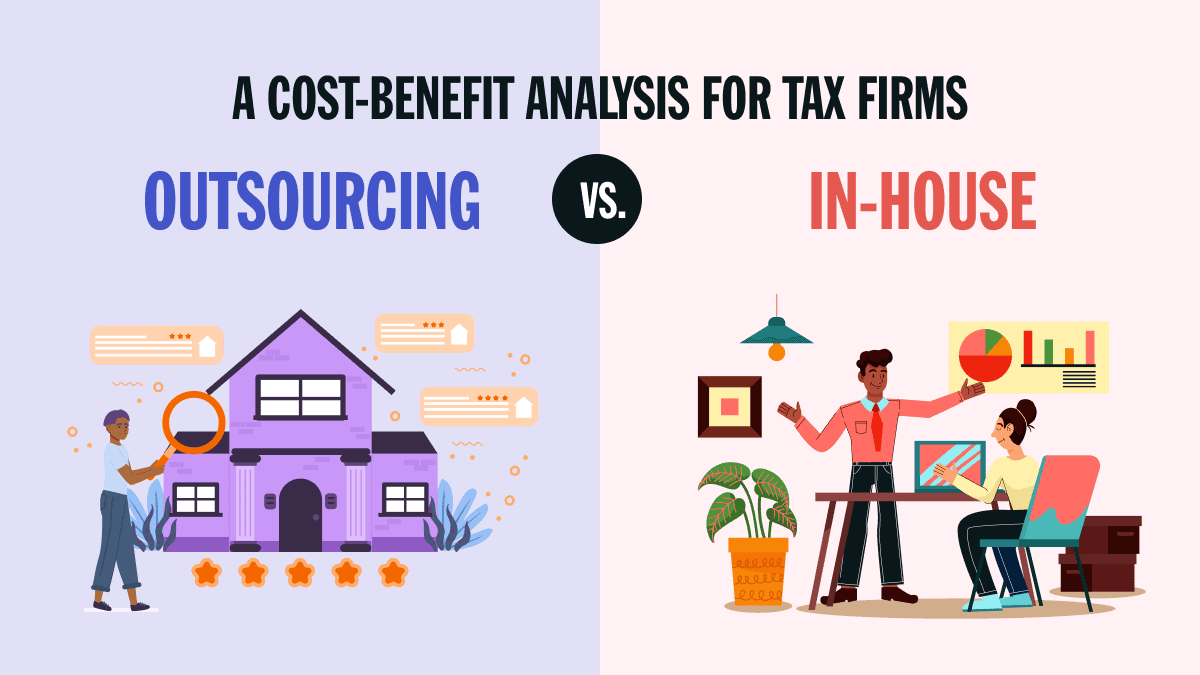Tax firms today face a crucial decision that can deeply impact their success: choosing between Outsourcing vs. In-House operations. This isn’t just a small choice; it’s about finding the best way to manage your work while saving money and improving quality. As you dive into the costs and benefits, you might wonder which option will truly help your firm thrive. Is it better to keep things in-house and have full control, or to outsource and tap into external expertise? This question is more than just practical—it’s essential for the growth and efficiency of your tax firm.
We’re here to guide you through Outsourcing vs. In-House debate, offering clear insights to help you make a well-informed decision. Whether you’re looking to expand your services or streamline your operations, understanding the real impact of your choice is the first step. Join us as we explore what’s best for your firm, paving the way for smarter, more strategic decisions.
Understanding Outsourcing
Outsourcing, the practice of hiring external entities to handle specific business functions, has emerged as a beacon for tax firms aiming to streamline their operations. This model is not a mere reduction of workload but a strategic partnership that offers access to global talent, cutting-edge technology, and innovative practices. For tax firms, outsourcing could encompass a spectrum of services, from routine tax filings and bookkeeping to intricate tax advisory and compliance management.
The allure of outsourcing lies in its promise of operational efficiency and cost savings. By tapping into the expertise of specialized service providers, tax firms can elevate the quality of their services without the burden of hefty investments in technology and training. Moreover, the scalability of outsourcing allows firms to adjust their service capacity in response to seasonal peaks and troughs, ensuring they remain lean and agile.
The In-House Approach
Conversely, the in-house model champions autonomy and control. By cultivating a dedicated team, tax firms can foster a deep-seated understanding of their operational ethos, business objectives, and client relationships. This internal ecosystem ensures that every tax solution is tailor-made to fit the specific needs of their clientele, enhancing client satisfaction and loyalty.
The in-house approach, however, comes with its set of challenges. The primary hurdle is the substantial initial investment required to build and maintain a competent team. This includes recruitment, ongoing training, and the adoption of technology. Moreover, the in-house model demands a continuous commitment to professional development to keep abreast of the rapidly evolving tax legislation and digital tools.
Cost Analysis
Delving into the financial implications, outsourcing presents an attractive proposition for tax firms looking to optimize their cost structure. The most apparent advantage is the elimination of overhead associated with hiring full-time staff, such as salaries, benefits, and office space. Additionally, outsourcing converts fixed costs into variable costs, providing firms with the flexibility to manage expenses in alignment with revenue fluctuations.
In comparison, the in-house model encapsulates a predictable cost framework but requires a significant upfront investment. This includes not only the tangible costs of salaries and infrastructure but also the intangible costs of developing and retaining expertise within the firm. Over time, however, an efficient in-house team can lead to economies of scale, where the per-unit cost of service delivery decreases as the volume of work handled internally increases.
Benefit Analysis
Outsourcing’s most compelling benefit is the instantaneous access it provides to a pool of experts and state-of-the-art technology. This can significantly enhance the quality and range of services offered by tax firms, from advanced tax planning to sophisticated compliance analytics. Furthermore, outsourcing partners often bring a fresh perspective to operational challenges, injecting innovation and best practices into the firm’s service portfolio.
In contrast, in-house operations excel in cultivating a culture of loyalty and commitment, both within the team and amongst the clientele. The personalized approach to client management can lead to deeper insights into clients’ needs, facilitating bespoke service delivery that can be a significant differentiator in the competitive tax services market.
Risk Considerations
Outsourcing, for all its merits, introduces an external dependency that can be a double-edged sword. Issues such as data security, confidentiality, and service continuity are paramount concerns. The reliance on third parties necessitates robust contractual agreements and continuous oversight to mitigate these risks.
In-house operations, while offering greater control over data and processes, are not without their challenges. The primary risk is the firm’s ability to maintain a skilled workforce capable of adapting to technological advancements and regulatory changes. This requires a proactive approach to training and development, alongside strategic recruitment to ensure the team’s capabilities remain cutting-edge.
Case Studies
Real-world examples underscore the nuanced decision-making involved in choosing between outsourcing and in-house operations. Tax firms that have leaned towards outsourcing often cite flexibility, cost efficiency, and access to specialized skills as pivotal benefits. On the flip side, those that prioritize in-house operations highlight client satisfaction, control over service delivery, and the cultivation of a dedicated team as their core advantages.
Making the Decision
The choice between outsourcing and in-house operations is contingent upon a myriad of factors, including the firm’s size, client base, and strategic objectives. Tax firms must conduct a thorough analysis of their operational needs, cost constraints, and long-term goals before embarking on either path. This decision should also consider the potential for technological integration and the need for scalability in response to market demands.
Conclusion
The debate between outsourcing and in-house operations in tax firms is a reflection of the broader strategic dilemmas facing modern businesses. By carefully weighing the costs, benefits, and risks associated with each model, tax firms can chart a path that aligns with their vision for growth and excellence in client service. Ultimately, the decision is not static but should be revisited periodically as the firm evolves and the marketplace shifts, ensuring that the chosen operational model continues to serve the firm’s best interests.


